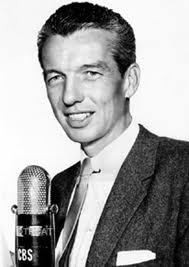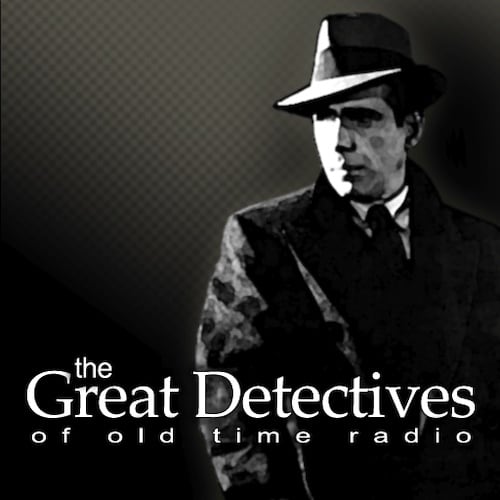Bob Bailey is a bit of an outlier among old-time radio stars. He led not one but two long-running detective programs for a total of twelve years (seven on Let George Go It and five on Yours Truly Johnny Dollar.) Yet the rest of his career is a bit of a mystery.
Gerald Mohr wasn’t just Philip Marlowe, Mike Malloy, the Lone Wolfe, and Bill Lance. He also played a recurring role on Our Miss Brooks as Mister LeBlanc, and he played multiple evildoers who got their comeuppance on The Whistler. He starred in a movie series and played Mister Fantastic on the 1960s Fantastic Four cartoons. Frank Lovejoy wasn’t just Randy Stone or John J Malone, he played multiple villains in Boston Blackie and Philo Vance, appeared in the Columbia Workshop, and starred in several films as well as the TV series The Adventures of McGraw. Jack Moyles wasn’t just Rocky Jordan, O’Hara, or Douglas of the World, he was a versatile character actor who had major recurring roles in The Line Up, while appearing everywhere from The Whistler and Suspense to Fibber McGee and Molly.
Bob Bailey’s surviving radiography was different. While other detective stars were not just doing the radio detective show, but also taking on a constant stream of guest projects, Bailey wasn’t, and when he did, it was often in very minor and brief “Let your mind wander and you’ll miss it” small roles. When an experienced Old Time Radio listener hears Gerald Mohr on another program, it’s a common occurrence. With Bailey, it’s noteworthy and sometimes a bit random. (Why did they hire him just to deliver two lines?) Bailey never appeared on many of the great anthology programs like Whistler, Escape, or even Favorite Story. He was never the feature star of Suspense, even in the late 1950s when bit actors like Vic Perrin were taking their turns.
What was the story of Bailey’s career and was there more to it than meets the eye? Let’s take a look. It’s an intriguing story that involves characters like Laurel and Hardy and Howard Hughes.
Second City Star
Bob Bailey was born into show business. He was born into an acting family, with his father also being a director. The story goes that he first appeared on stage when he was ten days old. Future Academy Award Winning Actress Faye Bainter was his godmother. Be that as it may, Bailey told Zuma Palmer in a 1957 interview that he made his first theatrical appearance in Mrs. Wiggs of the Cabbage Patch. In his childhood, he went on a tent show circuit and also was part of a Wild West show. He held various jobs in Chicago before his mother helped get him his first job in Chicago radio, where he quickly caught on with a variety of radio programs.
In 1935, he went to St. Louis and became the dramatic director of a local St. Louis station. In 1936, he returned to Chicago to get married to model Gloriana Royston. In July, a month after his 23rd birthday, a smiling Bob Bailey appeared beside actress Suzanne Shayne on page 40 of the Chicago Sun-Times. The two were Mr. and Mrs. Chicago on a morning daily radio program. According to John Dunning’s Encyclopedia of Old Time Radio, Bailey would be cast as the titular character in the comedy series Mortimer Gooch in November of that year. In 1957, Bailey reflected that he’d come up too soon and had to learn humility.
Bailey’s Chicago career was incredibly prolifigate, but like so much Chicago radio of the era, very little of it remains for modern listeners to enjoy. However, newspaper reports show him being involved in a variety of projects, such as the series Wings for America, about fifth columnists sabotaging America’s aircraft; a dramatization of the life of American Red Cross founder Clara Barton; the Cavalcade of Bankers; and daytime serials such as Kitty Keene and Fortunes of Emily.
We do have some samples of Bailey’s work from this era. In a circulating Chicago Theatre of the Air episode, he plays the speaking part of the hero in the musical Eileen. This was a common approach, with the seeming thought that with radio, there was no need for one performer to do both acting and singing, so they could get a great singer without having to worry about acting talent. Newspaper notices show that this was far from the only time Bailey did this. Bailey also had a recurring role on That Brewster Boy as Joey Brewster’s sister’s boyfriend. Brewster was played by Eddie Firestone, Jr. who would end up with a recurring role in the early days of Let George Do It.
Bailey also appeared in the Knickerbocker Playhouse, a series of light comedies and dramas, which worked on a similar formula to other programs like The First Nighter and Curtain Time, with Bailey playing a different role each week. The series was broadcast nationally and got the ear of Hollywood. According to Karl Schadow’s program guide for Radio Spirit’s Bob Bailey Collection, Bailey initially refused the call to Hollywood in 1941, but relented in 1942 and would make the rest of his career there.
Hollywood Struggles
Bailey came to Hollywood, made movies, and began to work in West Coast radio. One of his first appearances on radio was as a guest star on the Lionel Barrymore-led comedy-drama Mayor of the Town. Bailey played a war correspondent who leaves a war orphan in the care of the mayor. Bailey also appeared in several wartime radio shows. But of course, it was a film contract that led him to “Go West, Young Man”. In 1943 and 1944, he appeared in seven feature-length films, one short film, and a Navy training film. The films weren’t bad, but there wasn’t a star-making role to be found in any of them.
Bailey’s best part came as a result of a meeting at his godmother’s house according to a memorial by Lowell Thrugood. There, he was introduced to comic duo Laurel and Hardy. They were impressed by him, and with Faye Bainter’s help they got him his start with his first notable screen role. In the film Jitterbugs, he played conman Chester Wright, the male romantic lead. He’d also appear in another Laurel and Hardy film, The Dancing Masters. After 1944, it’d be nearly a decade before Bailey appeared in another film.
If Bailey didn’t acquire the humility he needed before leaving Chicago, then doubtless this period in his career did it. According to a newspaper article found by John Abbott, Bailey suffered an unknown major illness and confined his work to radio. He still continued to get work over radio, appearing in projects for producer/writer Arch Oboler such as Everything for the Boys and Arch Oboler’s Plays, but the parts were not great and gave him little chance to shine. Probably the best plays Bailey got in this era were the 1944 wartime Easter Play, This Living Book and the 1945 Cavalcade of America presentation, “The Lieutenants Come Home“, where he starred with Marjorie Reynolds in a play about a couple navigating the challenges of courtship during wartime.
For the most part, Bailey’s mid-1940s roles would see him in supporting roles to major stars like Burgess Meredith, Gregory Peck, and Chester Morris. Yet, even while laboring in obscurity, Bailey’s big break was not far away.
This series continues in Part Two…
Next time: Bob Bailey becomes a success…by accident.

